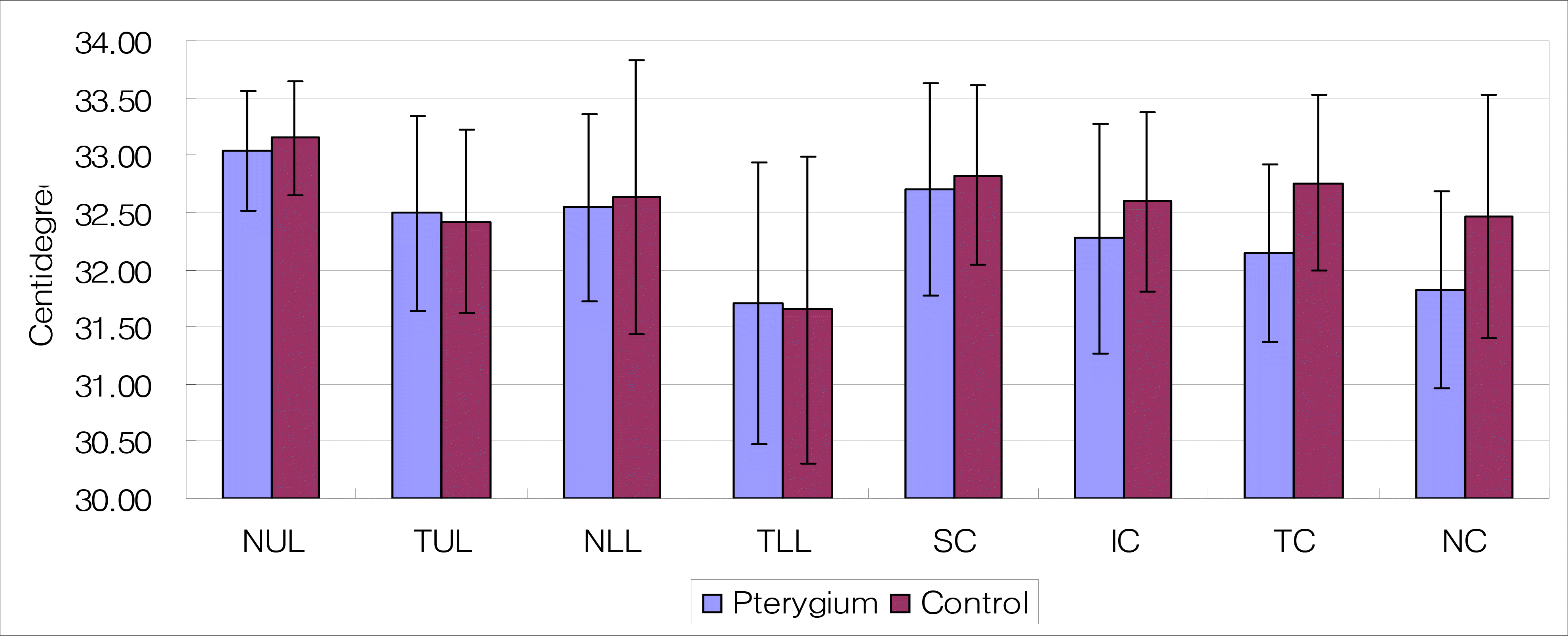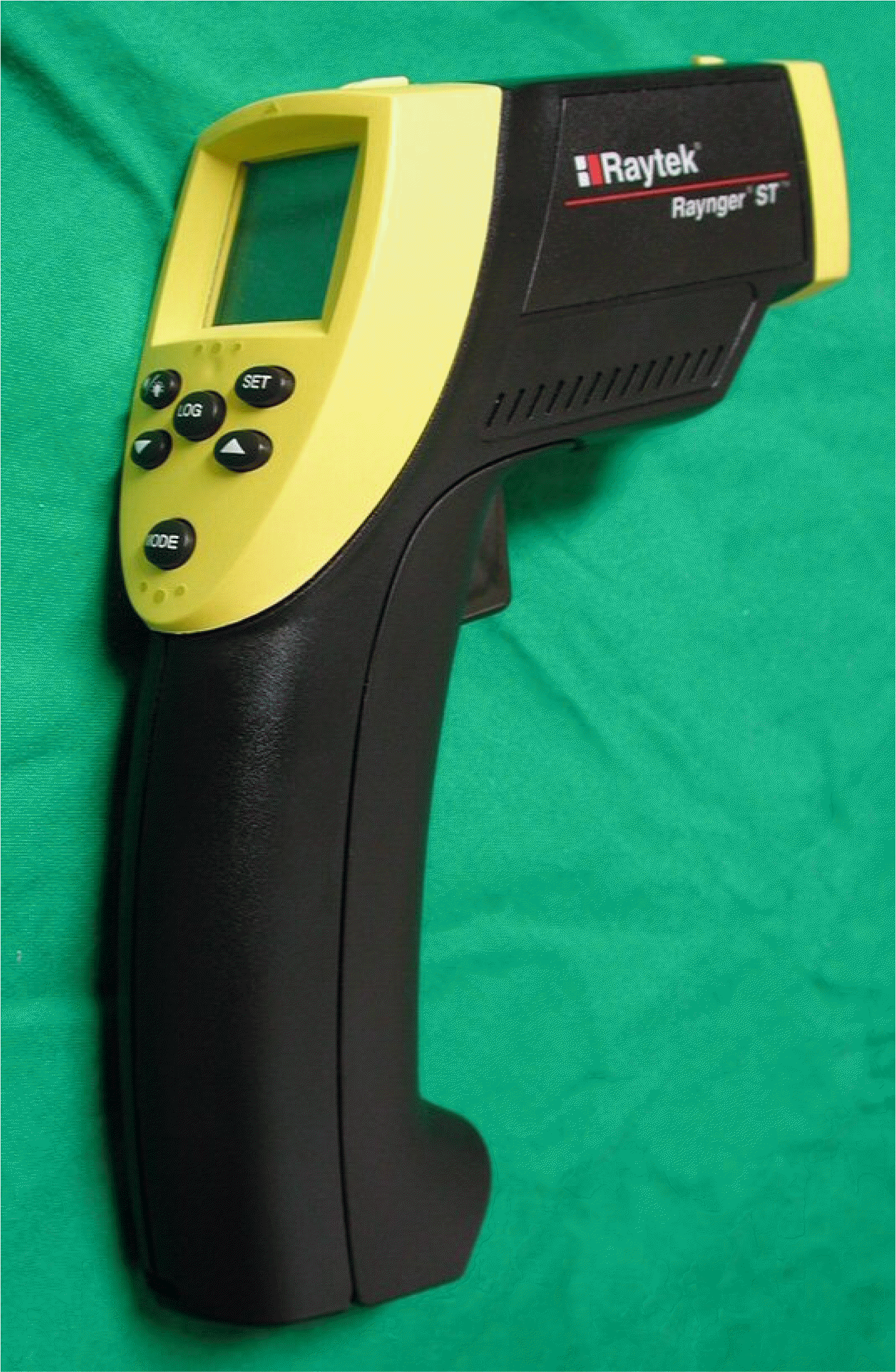Abstract
Purpose
To study the relationship between the distribution of the ocular surface temperature and the nasal predominance in pterygium.
Methods
In order to identify the distribution of the ocular surface, the surface temperature was measured at four points on the eyelids and on the bulbar conjunctiva with a non-contact thermometer. The ocular surface temperature in the pterygium patient group was compared with that in a normal control group. The temperature difference at each point on the ocular surface was also examined.
Results
In both of the patient and the normal groups, the surface temperature on the eyelid was at its lowest on the temporal lower eyelid, and highest on the nasal upper eyelid. On the bulbar conjunctiva, the surface temperature of the nasal conjunctiva was at its lowest, and at its highest on the upper conjunctiva. The most distinctive temperature difference between the patient and control groups was shown on the nasal and temporal bulbar conjunctivas, and statistically significant (p<0.05).
Go to : 
References
1. Austin P, Jakobiec FA, Iwamoto T. Elastodysplasia and elastodystrophy as the pathologic bases of ocular pterygia and pinguecula. Ophthalmology. 1983; 90:96–109.

2. Guyton AC, Hall JE. Textbook of medical physiology. 10th ed.1. Pennsylvenia: W.B. Saunders;2000. p. 822–6.
3. Dennis L. Kasper. Harrison's principles of internal medicine. 16th ed.1. New York: McGraw-hill;2005. p. 121–2.
4. Ceradini DJ, Kulkarni AR, Callaghan MJ, et al. Progenitor cell trafficking is regulated by hypoxic gradients through HIF‐1 induction of SDF-1. Nat Med. 2004; 10:858–64.

5. Ye J, Song YS, Kang SH, et al. Involvement of bone marrow-derived stem and progenitor cells in the pathogenesis of pterygium. Eye. 2004; 18:839–43.

6. Shimmura S, Ishioka M, Hanada K, et al. Telomerase activity and p53 expression in pterygia. Invest Ophthalmol Vis Sci. 2000; 41:1364–9.
7. Cameron ME. Ultra-violet radiation: Pterygium Throughout the World. 1st ed. 1. Springfield: Charles C Thomas;1965. p. 41–54.
8. Coroneo MT. Albedo concentration in the anterior eye: a phenomenon that locates some solar diseases. Ophthalmic Surg. 1990; 20:60–6.

10. Khoo J, Saw SM, Banerjee K, et al. Outdoor work and the risk of pterygia: a case-control study. Int ophthalmology. 1998; 22:293–8.
11. Wong WW. A hypothesis on the pathogenesis of pterygiums. Ann Ophthalmol. 1978; 10:303–9.
13. Varinli S, Varinli I, Koksal Erkisi M, Doran F. Human papillomavirus in pterygium. Cent Afr J Med. 1994; 40:24–6.
14. Pinkerton OD, Hokama Y, Shigemura La. Immunologic basis for the pathogenesis of the pterygium. Am J Ophthalmol. 1984; 98:225–8.
15. Tseng SC, Lee SB, Li DQ. Limbal stem cell deficiency in the pathogenesis of pterygium. 1st ed.1. Netherlands: Kugler Publications;2000. p. 41–56.
17. Fink S, Abraham E, Ehrlich H. Postoperative monitoring if conjunctival oxygen tension and temperature. Int J Clin Monit Comput. 1998; 5:37–43.
Go to : 
 | Figure 2.Result of ocular surface temperature (°C); NUL = nasal upper lid; TUL = temporal upper lid; NLL = nasal lower lid; TLL = temporal lower lid; SC = superior bulbar conjunctiva; IC = inferior bulbar conjunctiva; TC = temporal bulbar conjunctiva; NC = nasal bulbar conjunctiva. |
Table 1.
Clinic group al characteristics of p pterygium and control
| Pterygium group | Control group | |
|---|---|---|
| N (Eyes) | 14 (14) | 126 (252) |
| Mean Age | 63.29±11.25 | 61.39±13.55 |
| Sex (M/F) | 9/5 (1/0.56) | 79/47 (1/0.59) |
| Side (OD/OS) | 8/6 (1/0.75) | 126/126 (1/ 1) |
Table 2.
Ocular surface temperature (°C) and difference between the pterygium and control groups
| Pterygium group (Mean±SD)∗ | Control group (Mean±SD)∗ | P value† | |
|---|---|---|---|
| Nasal Upper Lid | 33.04±0.52 | 33.13±0.51 | 0.52 |
| Temporal Upper Lid | 32.49±0.85 | 32.44±0.83 | 0.95 |
| Nasal Lower Lid | 32.54±0.82 | 32.60±1.22 | 0.44 |
| Temporal Lower Lid | 31.70±1.23 | 31.63±1.32 | 0.73 |
| Superior Bulbar Conjunctiva | 32.70±0.93 | 32.80±0.75 | 0.61 |
| Inferior Bulbar Conjunctiva | 32.27±1.00 | 32.55±0.88 | 0.29 |
| Temporal Bulbar Conjunctiva | 32.15±0.78 | 32.72±0.78 | 0.01 |
| Nasal Bulbar Conjunctiva | 31.82±0.86 | 32.44±0.98 | 0.01 |




 PDF
PDF ePub
ePub Citation
Citation Print
Print



 XML Download
XML Download